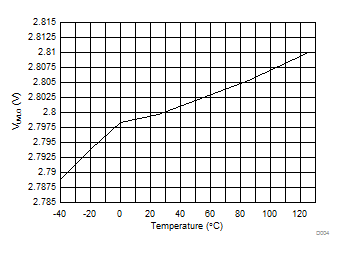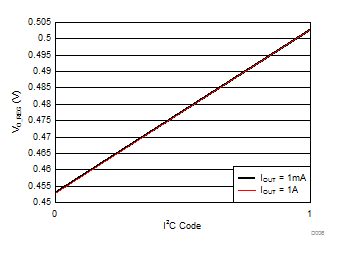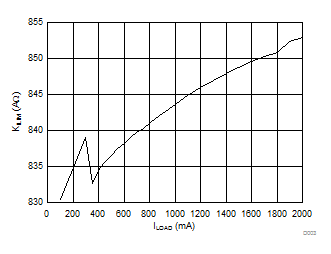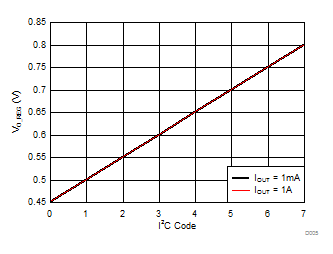SLUSBX7C September 2014 – March 2017
PRODUCTION DATA.
- 1 Features
- 2 Applications
- 3 Description
- 4 Revision History
- 5 Device Comparison Table
- 6 Pin Configuration and Functions
- 7 Specifications
-
8 Detailed Description
- 8.1 Overview
- 8.2 Functional Block Diagram
- 8.3
Feature Description
- 8.3.1 Dynamic Rectifier Control
- 8.3.2 Dynamic Power Scaling
- 8.3.3 VO_REG Calculations
- 8.3.4 RILIM Calculations
- 8.3.5 Adapter Enable Functionality
- 8.3.6 Turning Off the Transmitter
- 8.3.7 Communication Current Limit
- 8.3.8 PD_DET and TMEM
- 8.3.9 TS/CTRL
- 8.3.10 PMODE Pin
- 8.3.11 I2C Communication
- 8.3.12 Input Overvoltage
- 8.3.13 Alignment Aid Using Frequency Information
- 8.4 Device Functional Modes
- 8.5
Register Maps
- 8.5.1 Wireless Power Supply Current Register 1
- 8.5.2 Wireless Power Supply Current Register 2
- 8.5.3 Wireless Power Supply Current Register 3
- 8.5.4 I2C Mailbox Register
- 8.5.5 I2C Mailbox Register 2
- 8.5.6 I2C Mailbox Register 3
- 8.5.7 Wireless Power Supply FOD RAM
- 8.5.8 Wireless Power User Header RAM
- 8.5.9 Wireless Power USER VRECT Status RAM
- 8.5.10 Wireless Power VOUT Status RAM
- 8.5.11 Wireless Power Proprietary Mode REC PWR MSByte Status RAM
- 8.5.12 Wireless Power REC PWR LSByte Status RAM
- 8.5.13 Wireless Power Prop Packet Payload RAM Byte 0
- 8.5.14 Wireless Power Prop Packet Payload RAM Byte 1
- 8.5.15 Wireless Power Prop Packet Payload RAM Byte 2
- 8.5.16 Wireless Power Prop Packet Payload RAM Byte 3
-
9 Application and Implementation
- 9.1 Application Information
- 9.2
Typical Applications
- 9.2.1
WPC v1.2 Power Supply 7-V Output With 1.4-A Maximum Current With I2C
- 9.2.1.1 Design Requirements
- 9.2.1.2
Detailed Design Procedure
- 9.2.1.2.1 Output Voltage Set Point
- 9.2.1.2.2 Output and Rectifier Capacitors
- 9.2.1.2.3 TMEM
- 9.2.1.2.4 Maximum Output Current Set Point
- 9.2.1.2.5 I2C
- 9.2.1.2.6 Communication Current Limit
- 9.2.1.2.7 Receiver Coil
- 9.2.1.2.8 Series and Parallel Resonant Capacitors
- 9.2.1.2.9 Communication, Boot, and Clamp Capacitors
- 9.2.1.3 Application Curves
- 9.2.2 Standalone 10-V WPC v1.2 Power Supply With 1-A Maximum Output Current in System Board
- 9.2.3
Standalone 10-V Power Supply With 1-A Maximum Output Current for 2S Charging System
- 9.2.3.1 Design Requirements
- 9.2.3.2
Detailed Design Procedure
- 9.2.3.2.1 Output Voltage Set Point
- 9.2.3.2.2 Output and Rectifier Capacitors
- 9.2.3.2.3 TMEM
- 9.2.3.2.4 Maximum Output Current Set Point
- 9.2.3.2.5 I2C
- 9.2.3.2.6 Communication Current Limit
- 9.2.3.2.7 Receiver Coil
- 9.2.3.2.8 Series Resonant Capacitors
- 9.2.3.2.9 Communication, Boot, and Clamp Capacitors
- 9.2.3.2.10 VRECT Clamp
- 9.2.3.3 Application Curves
- 9.2.1
WPC v1.2 Power Supply 7-V Output With 1.4-A Maximum Current With I2C
- 10Power Supply Recommendations
- 11Layout
- 12Device and Documentation Support
- 13Mechanical, Packaging, and Orderable Information
Package Options
Mechanical Data (Package|Pins)
- YFP|42
Thermal pad, mechanical data (Package|Pins)
Orderable Information
7 Specifications
7.1 Absolute Maximum Ratings
over operating free-air temperature (unless otherwise noted)(1) (2)| MIN | MAX | UNIT | ||
|---|---|---|---|---|
| Input voltage | AC1, AC2 | –0.8 | 20 | V |
| RECT, COMM1, COMM2, OUT, CLAMP1, CLAMP2, WPG, PD_DET | –0.3 | 20 | ||
| AD, AD-EN | –0.3 | 30 | ||
| BOOT1, BOOT2 | –0.3 | 20 | ||
| SCL, SDA, PMODE, CM_ILIM, FOD, TS/CTRL, ILIM, TMEM, VIREG, VO_REG | –0.3 | 7 | ||
| Input current | AC1, AC2 (RMS) | 2.5 | A | |
| Output current | OUT | 2.5 | A | |
| Output sink current | WPG, PD_DET | 15 | mA | |
| Output sink current | COMM1, COMM2 | 1 | A | |
| TJ | Junction temperature | –40 | 150 | °C |
| Tstg | Storage temperature | –65 | 150 | °C |
(1) All voltages are with respect to the PGND pin, unless otherwise noted.
(2) Stresses beyond those listed under Absolute Maximum Ratings may cause permanent damage to the device. These are stress ratings only, and functional operation of the device at these or any other conditions beyond those indicated under Recommended Operating Conditions is not implied. Exposure to absolute-maximum-rated conditions for extended periods may affect device reliability.
7.2 ESD Ratings
| VALUE | UNIT | |||
|---|---|---|---|---|
| V(ESD) | Electrostatic discharge | Human body model (HBM) 100 pF, 1.5 kΩ(1) | ±2000 | V |
| Charged device model (CDM)(2) | ±500 | |||
(1) JEDEC document JEP155 states that 500-V HBM allows safe manufacturing with a standard ESD control process.
(2) JEDEC document JEP157 states that 250-V CDM allows safe manufacturing with a standard ESD control process.
7.3 Recommended Operating Conditions
over operating free-air temperature range (unless otherwise noted)| MIN | MAX | UNIT | ||
|---|---|---|---|---|
| VRECT | RECT voltage | 4 | 11 | V |
| IOUT | Output current | 2.0 | A | |
| IAD-EN | Sink current | 1 | mA | |
| ICOMM | COMMx sink current | 500 | mA | |
| TJ | Junction temperature | 0 | 125 | ºC |
7.4 Thermal Information
| THERMAL METRIC(1) | bq51025 | UNIT | |
|---|---|---|---|
| YFP (DSBGA) | |||
| 42 PINS | |||
| RθJA | Junction-to-ambient thermal resistance | 49.7 | °C/W |
| RθJC(top) | Junction-to-case (top) thermal resistance | 0.2 | °C/W |
| RθJB | Junction-to-board thermal resistance | 6.1 | °C/W |
| ψJT | Junction-to-top characterization parameter | 1.4 | °C/W |
| ψJB | Junction-to-board characterization parameter | 6.0 | °C/W |
(1) For more information about traditional and new thermal metrics, see the Semiconductor and IC Package Thermal Metrics application report.
7.5 Electrical Characteristics
over operating free-air temperature range (unless otherwise noted) , ILOAD = IOUT| PARAMETER | TEST CONDITIONS | MIN | TYP | MAX | UNIT | |
|---|---|---|---|---|---|---|
| VUVLO | Undervoltage lockout | VRECT: 0 to 3 V | 2.8 | 2.9 | V | |
| VHYS-UVLO | Hysteresis on UVLO | VRECT: 3 to 2 V | 393 | mV | ||
| VRECT-OVP | Input overvoltage threshold | VRECT: 5 to 16 V | 14.6 | 15.1 | 15.6 | V |
| VHYS-OVP | Hysteresis on OVP | VRECT: 16 to 5 V | 1.5 | V | ||
| VRECT(REG) | Voltage at RECT pin set by communication with primary | VOUT + 0.120 | Lower of VOUT + 0.2 or 11.0 | V | ||
| VRECT(TRACK) | VRECT regulation above VOUT | VILIM = 1.2 V | 140 | mV | ||
| ILOAD-HYS | ILOAD hysteresis for dynamic VRECT thresholds as a % of IILIM | ILOAD falling | 4% | |||
| VRECT-DPM | Rectifier undervoltage protection, restricts IOUT at VRECT-DPM | 3 | 3.1 | 3.2 | V | |
| VRECT-REV | Rectifier reverse voltage protection with a supply at the output | VRECT-REV = VOUT – VRECT, VOUT = 10 V |
8.8 | 9.2 | V | |
| QUIESCENT CURRENT | ||||||
| IOUT(standby) | Quiescent current at the output when wireless power is disabled | VOUT ≤ 5 V, 0°C ≤ TJ ≤ 85°C | 20 | 35 | µA | |
| ILIM SHORT CIRCUIT | ||||||
| RILIM-SHORT | Highest value of RILIM resistor considered a fault (short). Monitored for IOUT > 100 mA | RILIM: 200 to 50 Ω. IOUT latches off, cycle power to reset | 215 | 230 | Ω | |
| tDGL-Short | Deglitch time transition from ILIM short to IOUT disable | 1 | ms | |||
| ILIM_SC | ILIM-SHORT,OK enables the ILIM short comparator when IOUT is greater than this value | ILOAD: 0 to 200 mA | 110 | 125 | 140 | mA |
| ILIM-SHORT,OK HYSTERESIS | Hysteresis for ILIM-SHORT,OK comparator | ILOAD: 200 to 0 mA | 20 | mA | ||
| IOUT-CL | Maximum output current limit | Maximum ILOAD that can be delivered for 1 ms when ILIM is shorted | 3.7 | A | ||
| OUTPUT | ||||||
| VO_REG | Feedback voltage set point | ILOAD = 2000 mA, VO_REG resistor divider ratio = 9:1 | 0.4968 | 0.5019 | 0.5077 | V |
| ILOAD = 1 mA, VO_REG resistor divider ratio = 9:1 | 0.4971 | 0.5017 | 0.5079 | |||
| ILOAD = 1000 mA, VO_REG resistor divider ratio = 19:1 | 0.4977 | 0.5027 | 0.5091 | |||
| ILOAD = 1 mA, VO_REG resistor divider ratio = 19:1 | 0.4978 | 0.5029 | 0.5098 | |||
| KILIM | Current programming factor for hardware short circuit protection | RILIM = KILIM / IILIM, where IILIM is the hardware current limit IOUT = 900 mA |
842 | AΩ | ||
| IOUT_RANGE | Current limit programming range | 2300 | mA | |||
| ICOMM | Output current limit during communication | IOUT ≥ 400 mA | IOUT – 50 | mA | ||
| 100 mA ≤ IOUT < 400 mA | IOUT + 50 | |||||
| IOUT < 100 mA | 200 | |||||
| tHOLD-OFF | Hold off time for the communication current limit during startup | 1 | s | |||
| TS/CTRL | ||||||
| VTS-Bias | TS bias voltage (internal) | ITS-Bias < 100 µA and communication is active (periodically driven, see tTS/CTRL-Meas) | 1.8 | V | ||
| VCTRL-HI | CTRL pin threshold for a high | VTS/CTRL: 50 to 150 mV | 90 | 105 | 120 | mV |
| TTS/CTRL-Meas | Time period of TS/CTRL measurements, when TS is being driven | TS bias voltage is only driven when power packets are sent | 1700 | ms | ||
| VTS-HOT | Voltage at TS pin when device shuts down | 0.38 | V | |||
| THERMAL PROTECTION | ||||||
| TJ(OFF) | Thermal shutdown temperature | 155 | °C | |||
| TJ(OFF-HYS) | Thermal shutdown hysteresis | 20 | °C | |||
| OUTPUT LOGIC LEVELS ON WPG | ||||||
| VOL | Open-drain WPG pin | ISINK = 5 mA | 550 | mV | ||
| IOFF,STAT | WPG leakage current when disabled | VWPG = 20 V | 1 | µA | ||
| COMM PIN | ||||||
| RDS-ON(COMM) | COMM1 and COMM2 | VRECT = 2.6 V | 1 | Ω | ||
| ƒCOMM | Signaling frequency on COMMx pin for WPC | 2.00 | Kbps | |||
| IOFF,COMM | COMMx pin leakage current | VCOMM1 = 20 V, VCOMM2 = 20 V | 1 | µA | ||
| CLAMP PIN | ||||||
| RDS-ON(CLAMP) | CLAMP1 and CLAMP2 | 0.5 | Ω | |||
| ADAPTER ENABLE | ||||||
| VAD-EN | VAD rising threshold voltage | VAD 0 V to 5 V | 3.5 | 3.6 | 3.8 | V |
| VAD-EN-HYS | VAD-EN hysteresis | VAD 5 V to 0 V | 450 | mV | ||
| IAD | Input leakage current | VRECT = 0 V, VAD = 5 V | 50 | μA | ||
| RAD_EN-OUT | Pullup resistance from AD-EN to OUT when adapter mode is disabled and VOUT > VAD | VAD = 0 V, VOUT = 5 V | 230 | 350 | Ω | |
| VAD_EN-ON | Voltage difference between VAD and VAD-EN when adapter mode is enabled | VAD = 5 V, 0°C ≤ TJ ≤ 85°C | 4 | 4.5 | 5 | V |
| VAD = 9 V, 0°C ≤ TJ ≤ 85°C | 3 | 6 | 7 | V | ||
| SYNCHRONOUS RECTIFIER | ||||||
| ISYNC-EN | IOUT at which the synchronous rectifier enters half synchronous mode | IOUT: 200 to 0 mA | 100 | mA | ||
| ISYNC-EN-HYST | Hysteresis for IOUT,RECT-EN (full-synchronous mode enabled) | IOUT: 0 to 200 mA | 40 | mA | ||
| VHS-DIODE | High-side diode drop when the rectifier is in half synchronous mode | IAC-VRECT = 250 mA, and TJ = 25°C |
0.7 | V | ||
| I2C | ||||||
| VIL | Input low threshold level SDA | V(PULLUP) = 1.8 V, SDA | 0.4 | V | ||
| VIH | Input high threshold level SDA | V(PULLUP) = 1.8 V, SDA | 1.4 | V | ||
| VIL | Input low threshold level SCL | V(PULLUP) = 1.8 V, SCL | 0.4 | V | ||
| VIH | Input high threshold level SCL | V(PULLUP) = 1.8 V, SCL | 1.4 | V | ||
| I2C speed | Typical | 100 | kHz | |||
7.6 Typical Characteristics
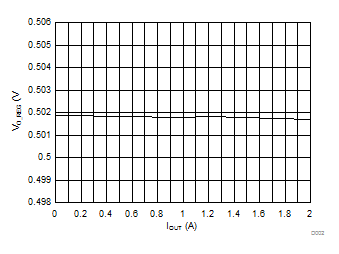
| Temperature = 25°C | ||
